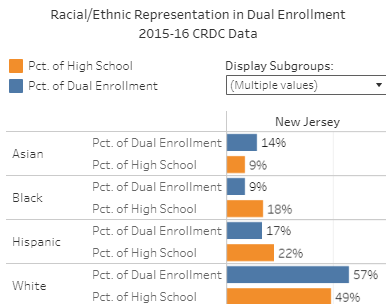By Elizabeth Cooner and Angie Nga Le
Dual enrollment programs allow high school students to take college courses, helping them explore college options and get a jump start on their postsecondary education. In New Jersey, these programs are one of the key measures in providing pathways to college and supporting the state’s vision of high-quality postgraduate credentials for all residents[1].
In October 2024, the Community College Research Center released a report analyzing nationwide dual enrollment outcomes, including state-specific insights[2]. The report uses data from the National Student Clearinghouse on students who began dual enrollment coursework in 2015, tracking their progress four years after high school. The data dashboard[3] accompanying this report reveals several key findings about dual enrollment students’ outcomes in New Jersey.
In fall 2015, about 9% of undergraduates entering postsecondary education in New Jersey were current dual enrollment students. This proportion was higher in community colleges, where 13% of students were dual enrollees, compared to only 6% in four-year institutions. Across the country, 13% of new undergraduates were enrolled in dual enrollment coursework in fall 2015, including 21% of community college students.
The high school students dually enrolled for the first time in fall 2015 within New Jersey were more likely to be women (58%) than men (42%). Additionally, 62% resided in high-income neighborhoods; 12% in middle-income neighborhoods, and 18% in low-income neighborhoods. Comparing the racial/ethnic distribution of first-time dual enrollment students to the racial/ethnic distribution of all high school students across the state, White (57% vs. 49%) and Asian (14% vs. 9%) students represented a higher share of those in dual enrollment courses, while those who were Hispanic (17% vs. 22%) and Black (9% vs. 18%) constituted a smaller share of those enrolled in such courses (Figure 1).
Figure 1

Source: March, D., Fink, J., & Velasco, T. (2024). State Findings: Dual Enrollment Student Outcomes. https://ccrc.tc.columbia.edu/dual-enrollment.html
The outcomes for dual enrollment students in New Jersey were fairly robust compared to those nationwide (Figure 2). In the year following high school, 83% of dual enrollment students were enrolled in higher education, with about 24% attending community colleges and 58% enrolling in four-year institutions. Nationally, trends were similar, with 81% of dual enrollment students transitioning to postsecondary education – 30% enrolling in community colleges and 51% in four-year institutions.
Figure 2

Source: March, D., Fink, J., & Velasco, T. (2024). State Findings: Dual Enrollment Student Outcomes. https://ccrc.tc.columbia.edu/dual-enrollment.html
College participation rates among low-income, Hispanic, and Black dual enrollees in New Jersey were lower than the overall state level. The largest gap was observed among low-income students (71%), who were 12 percentage points below the state average of 83%, while Black (77%) and Hispanic (80%) students fell short by six and three percentage points, respectively. Notably, low-income and Hispanic dual enrollment students in New Jersey who enrolled in college the first year after high school were more likely than others to enroll in community colleges, at 27% and 32%, respectively, compared to the state overall rate of 24%.
Four years after high school, 51% of New Jersey students who had first enrolled in dual enrollment courses in 2015 earned any postsecondary award (including associate degrees and certificates), with 42% obtaining a bachelor’s degree. These figures are considerably higher than the national averages of 42% and 29%, respectively. However, low-income, Black and Hispanic dual enrollees in New Jersey continued to fall behind the overall state completion rates, showing significant disparities. Only 29% of low-income students in New Jersey completed a higher education award, a 22-percentage point difference compared to the general state rate (29% vs. 51%). Meanwhile, the corresponding nationwide disparity for low-income students is just six percentage points (36% vs. 42%). For Black (33% vs. 51%) and Hispanic (39% vs. 51%) students in New Jersey, the disparities are 18 and 12 percentage points, respectively, compared to an eight-percentage point gap for both groups nationally (34% vs. 42%).
Additionally, the proportion of dual enrollees in New Jersey who earned a bachelor’s degree within four years after high school (50%) was 14 percentage points higher than that of students without dual enrollment (36%) (Figure 3). This gap is much larger than nationwide, where the bachelor’s degree completion rate among students who had dually enrolled in postsecondary courses was just two percentage points ahead of those who had not taken such courses while in high school (36% vs. 34%).
Compared to other states, New Jersey’s postsecondary enrollment rate one year after high school among dual enrollment students was relatively high, ranking 20th among states with a rate of 83%. The top three states for higher education enrollment rates among dually enrolled students one year after high school were Mississippi (93%), Georgia (91%), and Oklahoma (90%). Additionally, New Jersey ranked third among states for the proportion of dual enrollment students who completed any postsecondary degree or certificate within four years after high school. The state, with its rate of 51%, was positioned behind Florida (57%) and Mississippi (56%). Four in ten dual enrollment students in New Jersey (42%) had completed a bachelor’s degree four years after high school, trailing Georgia (45%), Washington D.C. (45%), and Pennsylvania (43%).
Figure 3


Source: March, D., Fink, J., & Velasco, T. (2024). State Findings: Dual Enrollment Student Outcomes. https://ccrc.tc.columbia.edu/dual-enrollment.html
References:
[1] Office of the Secretary of Higher Education. NJ State Plan for Higher Education: Where Opportunity Meets Innovation. https://www.nj.gov/highereducation/stateplan.shtml
[2] Velasco, T., Fink, J., Bedoya-Guevara, M., & Jenkins, D. (2024). The Postsecondary Outcomes of High School Dual Enrollment Students: A National and State-by-State Analysis. https://ccrc.tc.columbia.edu/publications/postsecondary-outcomes-dual-enrollment-national-state.html
[3] March, D., Fink, J., & Velasco, T. (2024). State Findings: Dual Enrollment Student Outcomes. https://ccrc.tc.columbia.edu/dual-enrollment.html

